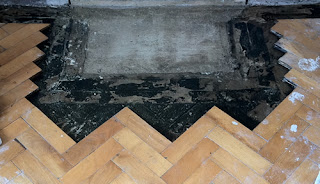Today I'll try and advise on an issue that can effect if the final touches to your hard work will look any good or not...Yes its the contentious issue of Lacquer application...Do you use a standard Roller...or a more professional 'T' Bar applicator.
When I first started floor sanding, I was shown by a very experienced floor sanding operator how to use a 'T' Bar applicator, and boy did he make it look easy, in the hands of an experienced pro it looks simplicity itself to put lacquer down correctly...Pahhhhh I thought, what's all the fuss about, its easy - I can do that.
Now I can do it easily, but it took many months before I became accomplished with the Padco Bigfoot, its nowhere near as easy as it looks.
The image on the left is the Padco Bigfoot floor lacquer applicator, the operator is applying lacquer, likely to a large area. The Padco Bigfoot and applicators of its type are just superb for putting lacquer down to large area's, I myself have used this applicator scores of times with nothing but a top class result, in the hands of a professional its possible to get a near flawless finish to large area's pretty quickly.
However, I really wouldn't recommend this applicator for the very occasional DIYer, who is just using it for one or two rooms. The Padco is not at its best in small area's, for a professional its straightforward, but for the inexperienced user this tool will be difficult to use properly, to obtain a high quality of finish to your project.
For an end user who hasn't much [or no] experience I would highly recommend using a roller for applying the lacquers to your wood floor. Once you have the floor correctly prepared and readied, use a 4" foam roller to cut in, and either a 9" or 12" roller and cage for the main lacquer application duties.
 The image on the right is a 9" roller and is obviously being used to correctly apply a lacquer product to a wooden floor, in this case a mosaic parquet. For just about all the Sand & Seal jobs I do these days I tend to use a roller, as I find the overall finish that you get, especially in smaller areas is just much better than using a Padco Bigfoot.
The image on the right is a 9" roller and is obviously being used to correctly apply a lacquer product to a wooden floor, in this case a mosaic parquet. For just about all the Sand & Seal jobs I do these days I tend to use a roller, as I find the overall finish that you get, especially in smaller areas is just much better than using a Padco Bigfoot.We tend to use either a 15" or 18" version of the image to the right. Whichever size roller you use make sure that the pile length is around the 8mm mark, this is pretty much the optimum roller sleeve pile length for applying lacquer to a wooden floor, if the pile is say 13mm, the roller has a tendency to 'splatter' the lacquer over the surface and it just takes a lot longer to apply the product [lacquer] correctly to the floor.
If you use a short pile length roller of around 5mm the roller tends to flood easily and again it takes alot longer to apply the lacquer correctly, many manufacturers supply and recommend their own rollers and roller sleeves, if you are not confident about sourcing the correct roller/sleeve products then I would heartily recommend purchasing the manufacturers own branded roller/sleeve as you are much more likely to get a better finish, especially if you do your homework in the first place, most manufacturers have this type of information on their respective websites.
Plus there is You Tube, which is a veritable gold mine of information on this subject. Type in 'apply bona mega' as an example and you will quickly find dozens of videos showing how to apply flooring lacquer.
Hope that helps, Thanks for reading.
I have recently received an email from JD Floors asking for some advice on how to fix an Alto Floorcrafter, which is cutting too hard to the left, Unfortunately I have no experience whatsoever of this machine, but I did do a quick Google search and it looks a quality piece of kit.
I myself use Bona floor sanding machinery, Bona have an excellent instructional video which may be of help, as most professional floor sanding machines are built to very similar principles so the clip may just be of use, follow the link below.
Bona Instructional Video






